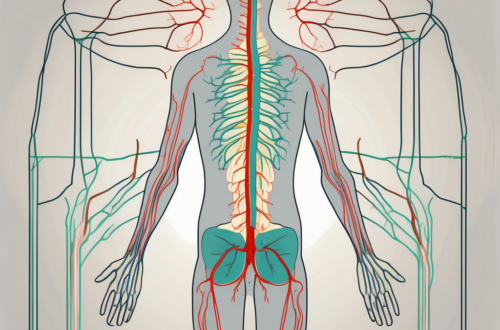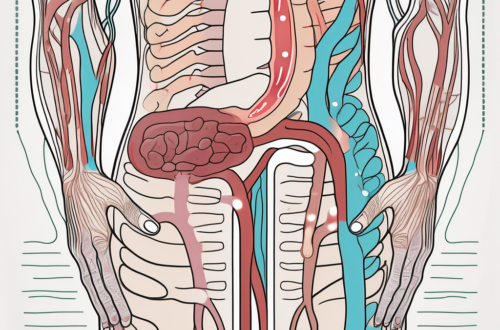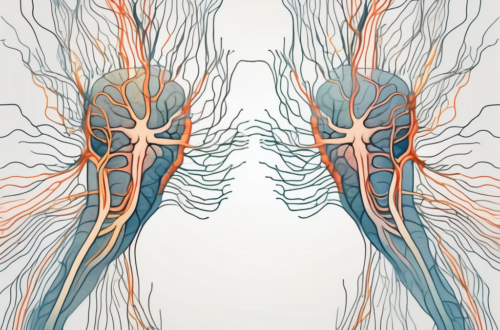Parasympathetic nerve damage is a condition that can have a significant impact on an individual’s overall well-being. It can affect various bodily functions and lead to a range of symptoms that can greatly disrupt daily life. In order to better understand the effects of parasympathetic nerve damage, it is essential to have a comprehensive understanding of the condition, its causes, symptoms, diagnostic methods, treatment options, and strategies for living with it.
The Basics of the Parasympathetic Nervous System
The parasympathetic nervous system is a vital part of the autonomic nervous system, which controls the body’s automatic functions. It works in opposition to the sympathetic nervous system, helping to maintain balance and regulate bodily processes. The parasympathetic nervous system stimulates activities that occur during rest, relaxation, and digestion.
When we think of the parasympathetic nervous system, we often associate it with a sense of calm and tranquility. It is responsible for promoting a state of relaxation and rest, allowing our bodies to recover and rejuvenate. This system plays a crucial role in maintaining our overall well-being.
One of the primary functions of the parasympathetic nervous system is to conserve energy. It does this by slowing down certain bodily processes, such as heart rate and metabolism. By conserving energy, the parasympathetic nervous system helps us to rest and recover, ensuring our bodies are ready for the next day’s activities.
The Role and Function of the Parasympathetic Nervous System
The primary role of the parasympathetic nervous system is to conserve energy and promote calming and restorative functions. It controls involuntary actions, such as digestion, metabolism, and heart rate, enabling our bodies to maintain a relaxed state.
When we engage in activities that promote relaxation, such as deep breathing exercises or meditation, we are actively stimulating the parasympathetic nervous system. This allows us to enter a state of rest and restoration, where our bodies can repair and heal themselves. The parasympathetic nervous system also plays a vital role in promoting proper digestion and absorption of nutrients, ensuring our bodies receive the necessary fuel for optimal functioning.
Additionally, the parasympathetic nervous system is involved in regulating heart rate and blood pressure. When we are in a relaxed state, the parasympathetic nervous system helps to slow down our heart rate, reducing stress on the cardiovascular system. This is why activities such as yoga or gentle stretching can have a calming effect on both the mind and body.
The Anatomy of the Parasympathetic Nervous System
The parasympathetic nervous system is composed of various structures located within the brain and spinal cord. Key components include the cranial nerves, which emerge from the brainstem and innervate different organs, and the sacral nerves, which arise from the lower segments of the spinal cord. These nerves allow for communication and control over vital bodily functions such as digestion, urination, and sexual arousal.
One of the most well-known cranial nerves associated with the parasympathetic nervous system is the vagus nerve. This nerve plays a crucial role in regulating digestion, as it innervates the stomach, liver, and intestines. It also helps to control heart rate and breathing, further highlighting the interconnectedness of the parasympathetic nervous system with various bodily functions.
Another important component of the parasympathetic nervous system is the sacral nerves. These nerves are responsible for controlling functions related to reproduction and sexual arousal. They play a vital role in the release of hormones and the coordination of sexual responses, ensuring the continuation of our species.
Overall, the parasympathetic nervous system is a complex and intricate network of structures that work together to promote rest, relaxation, and proper bodily functioning. By understanding its role and anatomy, we can appreciate the importance of maintaining a healthy balance between the parasympathetic and sympathetic nervous systems for overall well-being.
Causes of Parasympathetic Nerve Damage
Parasympathetic nerve damage can occur due to various factors, including diseases and injuries.
The parasympathetic nervous system plays a crucial role in regulating bodily functions, such as digestion, salivation, and sexual arousal. When this system is damaged, it can lead to a wide range of symptoms and complications.
Diseases Leading to Parasympathetic Nerve Damage
There are several diseases that can cause damage to the parasympathetic nervous system. These include but are not limited to: autoimmune disorders, such as Sjögren’s syndrome and multiple sclerosis; diabetes mellitus; viral infections, such as Lyme disease and human immunodeficiency virus (HIV); and certain neurodegenerative disorders, like Parkinson’s disease.
In autoimmune disorders, the body’s immune system mistakenly attacks its own tissues, including the parasympathetic nerves. This can result in inflammation and damage to the nerves, disrupting their normal functioning. Similarly, in neurodegenerative disorders like Parkinson’s disease, the gradual loss of nerve cells in the brain can affect the parasympathetic nervous system, leading to various symptoms such as constipation, urinary problems, and difficulty swallowing.
Diabetes mellitus, a chronic metabolic disorder, can also contribute to parasympathetic nerve damage. High blood sugar levels over time can cause damage to the blood vessels that supply the nerves, impairing their ability to transmit signals effectively. This can result in gastrointestinal issues, bladder dysfunction, and sexual problems.
Accidents and Injuries Resulting in Parasympathetic Nerve Damage
Accidents and injuries involving trauma to the head, neck, or spinal cord can also lead to damage of the parasympathetic nervous system. For example, a severe blow to the head or a spinal cord injury may disrupt the normal functioning of the nerves, impairing their ability to transmit signals effectively.
In cases of head trauma, the impact can cause direct damage to the parasympathetic nerves or lead to bleeding or swelling in the brain, which can indirectly affect their function. Similarly, injuries to the neck or spinal cord can result in compression or damage to the nerves that control parasympathetic responses.
It is important to note that the severity and extent of parasympathetic nerve damage can vary depending on the underlying cause and individual factors. Early diagnosis and appropriate treatment are crucial in managing the symptoms and preventing further complications associated with parasympathetic nerve damage.
Symptoms and Effects of Parasympathetic Nerve Damage
The symptoms and effects of parasympathetic nerve damage can vary depending on the extent of the damage and the specific nerves affected.
Parasympathetic nerve damage can have a range of physical symptoms that can greatly impact an individual’s daily life. One common physical symptom is digestive problems. This can manifest as constipation, making it difficult for individuals to have regular bowel movements. Additionally, some may experience difficulty swallowing or excessive salivation, which can be both uncomfortable and inconvenient.
Another physical symptom of parasympathetic nerve damage is urinary and bladder dysfunction. This can include urinary retention, where individuals have difficulty emptying their bladder completely, leading to discomfort and potential complications. On the other hand, some individuals may experience urinary incontinence, where they have little control over their bladder, resulting in involuntary leakage.
Parasympathetic nerve damage can also affect the cardiovascular system. It can lead to a decreased heart rate, making it difficult for the heart to pump blood efficiently. This can result in feelings of fatigue and weakness, as well as irregular heart rhythms, which can be alarming and potentially dangerous.
Impaired vision is another physical symptom that can occur due to parasympathetic nerve damage. Changes in pupil size can affect how light enters the eye, leading to difficulties in focusing and seeing clearly. Additionally, dry eyes can occur, causing discomfort and potentially affecting vision quality.
Aside from the physical symptoms, parasympathetic nerve damage can also have psychological effects. The parasympathetic nervous system plays a crucial role in regulating emotions, so damage to these nerves can lead to emotional imbalances. Some individuals may experience increased anxiety, making it difficult to cope with everyday stressors. Mood swings can also occur, causing sudden shifts in emotions that can be challenging to manage. Furthermore, decreased libido, or a decrease in sexual desire, can be a result of parasympathetic nerve damage, as this system is involved in sexual response.
Diagnosing Parasympathetic Nerve Damage
The diagnosis of parasympathetic nerve damage typically involves a comprehensive assessment of an individual’s medical history, physical examination, and advanced diagnostic tests.
Parasympathetic nerve damage can have a significant impact on an individual’s overall health and well-being. It can lead to a variety of symptoms, including abnormal heart rhythms, bladder dysfunction, and structural abnormalities in the brain or spinal cord. To accurately diagnose parasympathetic nerve damage, healthcare providers employ a multi-faceted approach that combines medical history, physical examination, and advanced diagnostic tests.
Medical History and Physical Examination
During the medical history and physical examination, a healthcare provider will ask detailed questions about symptoms, perform a neurological examination, and evaluate the patient’s overall health. This information can help identify any potential underlying causes or contributing factors.
Medical history plays a crucial role in the diagnostic process as it provides valuable insights into the patient’s past medical conditions, medications, and lifestyle factors. By understanding the patient’s medical history, healthcare providers can better assess the potential causes of parasympathetic nerve damage.
Additionally, a thorough physical examination allows healthcare providers to evaluate the patient’s overall health and identify any physical signs or symptoms that may be indicative of parasympathetic nerve damage. This examination may include assessing heart rate and rhythm, checking for abnormalities in bladder function, and examining the brain and spinal cord for any structural abnormalities.
Diagnostic Tests for Parasympathetic Nerve Damage
Advanced diagnostic tests may also be employed to confirm the presence of parasympathetic nerve damage. These tests can include electrocardiograms (ECGs) to examine heart rhythms, urodynamic studies to evaluate bladder function, and special imaging techniques, such as magnetic resonance imaging (MRI), to visualize any structural abnormalities in the brain or spinal cord.
Electrocardiograms (ECGs) are commonly used to assess the electrical activity of the heart and can help identify any irregular heart rhythms that may be associated with parasympathetic nerve damage. Urodynamic studies, on the other hand, involve measuring bladder pressure and urine flow to evaluate the function of the bladder and identify any abnormalities that may be caused by parasympathetic nerve damage.
In some cases, healthcare providers may also recommend special imaging techniques, such as magnetic resonance imaging (MRI), to obtain detailed images of the brain or spinal cord. These imaging techniques can help identify any structural abnormalities that may be contributing to parasympathetic nerve damage.
Overall, the diagnosis of parasympathetic nerve damage requires a comprehensive approach that combines medical history, physical examination, and advanced diagnostic tests. By gathering detailed information and employing various diagnostic tools, healthcare providers can accurately diagnose parasympathetic nerve damage and develop an appropriate treatment plan to address the underlying causes and manage the associated symptoms.
Treatment Options for Parasympathetic Nerve Damage
Parasympathetic nerve damage can be a challenging condition to manage, as there is currently no cure. However, there are various treatment options available that can help alleviate symptoms and improve the overall quality of life for individuals affected by this condition.
Medications for Parasympathetic Nerve Damage
One of the primary approaches to managing parasympathetic nerve damage is through the use of medications. These medications are specifically prescribed to target and alleviate the specific symptoms associated with this condition.
For example, individuals experiencing excessive salivation or an overactive bladder may be prescribed anticholinergic drugs. These medications work by blocking the action of acetylcholine, a neurotransmitter responsible for stimulating the parasympathetic nervous system. By doing so, they can help reduce the production of saliva and control bladder function.
In addition to anticholinergic drugs, there are also medications available that specifically target autonomic dysfunction. Autonomic dysfunction refers to the impairment of the autonomic nervous system, which is responsible for regulating various bodily functions such as heart rate and blood pressure. Medications targeting autonomic dysfunction can help regulate these functions and improve overall cardiovascular health.
Therapies and Rehabilitation for Parasympathetic Nerve Damage
While medications can be effective in managing symptoms, they are often complemented by therapies and rehabilitation programs. These approaches aim to improve muscle strength, coordination, balance, and mobility, as well as provide guidance on managing activities of daily living.
Physical therapy is a commonly recommended therapy for individuals with parasympathetic nerve damage. Physical therapists work closely with patients to develop personalized exercise programs that target specific muscle groups and help improve overall strength and flexibility. These exercises can also help individuals regain control over their movements and improve coordination.
Occupational therapy is another valuable resource for individuals with parasympathetic nerve damage. Occupational therapists focus on helping patients regain independence in their daily activities. They provide strategies and techniques to manage tasks such as dressing, grooming, and eating, ensuring that individuals can maintain a good quality of life despite the challenges posed by their condition.
Furthermore, occupational therapists may also recommend assistive devices or modifications to the home environment to enhance safety and accessibility. These adaptations can include grab bars in the bathroom, ramps for wheelchair access, and specialized utensils for easier eating.
Overall, the combination of medications, therapies, and rehabilitation programs can significantly improve the management of parasympathetic nerve damage. While a cure may not be available at present, these treatment options offer hope and support for individuals affected by this condition, allowing them to lead fulfilling and meaningful lives.
Living with Parasympathetic Nerve Damage
Living with parasympathetic nerve damage can present unique challenges, but there are strategies and lifestyle modifications that can help individuals manage their condition effectively.
Parasympathetic nerve damage occurs when there is an impairment in the functioning of the parasympathetic nervous system, which is responsible for controlling involuntary bodily functions such as digestion, heart rate, and bladder control. This can result in a range of symptoms, including digestive issues, irregular heart rate, and urinary problems.
Adopting a healthy lifestyle that includes regular exercise, a balanced diet, adequate sleep, stress management techniques, and avoiding known triggers can all help improve overall well-being. Regular exercise, such as walking or swimming, can help stimulate the parasympathetic nervous system and promote better digestion. A balanced diet rich in fiber, fruits, and vegetables can aid in maintaining regular bowel movements and preventing constipation, a common issue for individuals with parasympathetic nerve damage.
Adequate sleep is essential for the body to repair and regenerate itself. Creating a relaxing bedtime routine and ensuring a comfortable sleep environment can help individuals with parasympathetic nerve damage achieve restful sleep. Stress management techniques, such as deep breathing exercises, meditation, or yoga, can also be beneficial in reducing stress levels and promoting overall well-being.
In addition to lifestyle changes, individuals may benefit from using assistive devices to enhance their functional abilities. Mobility aids, such as canes or walkers, can provide support and stability for individuals with balance issues. Special utensils with ergonomic designs can make eating and drinking easier for those with impaired hand coordination.
Coping and Support for Individuals with Parasympathetic Nerve Damage
Having a strong support system is crucial for individuals with parasympathetic nerve damage. Coping with a chronic condition can be emotionally challenging, and seeking emotional support from friends, family, or support groups can provide a sense of understanding and empowerment. Connecting with others who are going through similar experiences can help individuals feel less isolated and provide a platform for sharing coping strategies and tips.
It is also important to consult with healthcare professionals who can offer guidance and specialized care. Neurologists, physiotherapists, and occupational therapists can provide valuable insights and develop personalized treatment plans to manage the symptoms of parasympathetic nerve damage. Regular check-ups and open communication with healthcare providers can help individuals stay informed about the latest advancements in treatment options and make informed decisions about their care.
Living with parasympathetic nerve damage may require adjustments and accommodations, but with the right strategies and support, individuals can lead fulfilling lives. By taking proactive steps to manage their condition and seeking the necessary support, individuals can navigate the challenges of parasympathetic nerve damage with resilience and determination.
Prevention of Parasympathetic Nerve Damage
While it may not be entirely possible to prevent all instances of parasympathetic nerve damage, certain healthy habits and regular check-ups can help promote nervous system health and identify any potential issues at an early stage.
Healthy Habits for Nervous System Health
Engaging in regular physical exercise, eating a balanced diet rich in nutrients, managing stress levels, and avoiding excessive alcohol consumption and smoking can contribute to maintaining a healthy nervous system.
Regular Check-ups and Early Detection
Scheduling regular check-ups with a healthcare provider is essential for overall well-being. Routine examinations can help identify any early signs of parasympathetic nerve damage or underlying conditions, allowing for timely intervention and management.
In conclusion, understanding the effects of parasympathetic nerve damage is essential for individuals and healthcare professionals alike. By comprehensively exploring the basics of the parasympathetic nervous system, its causes, symptoms, diagnostic methods, treatment options, and strategies for living with this condition, individuals can gain valuable insight into their own experiences. It is worth noting that while this guide provides an overview of the topic, consulting with a healthcare professional is always advised for accurate diagnosis, treatment, and individualized care.





